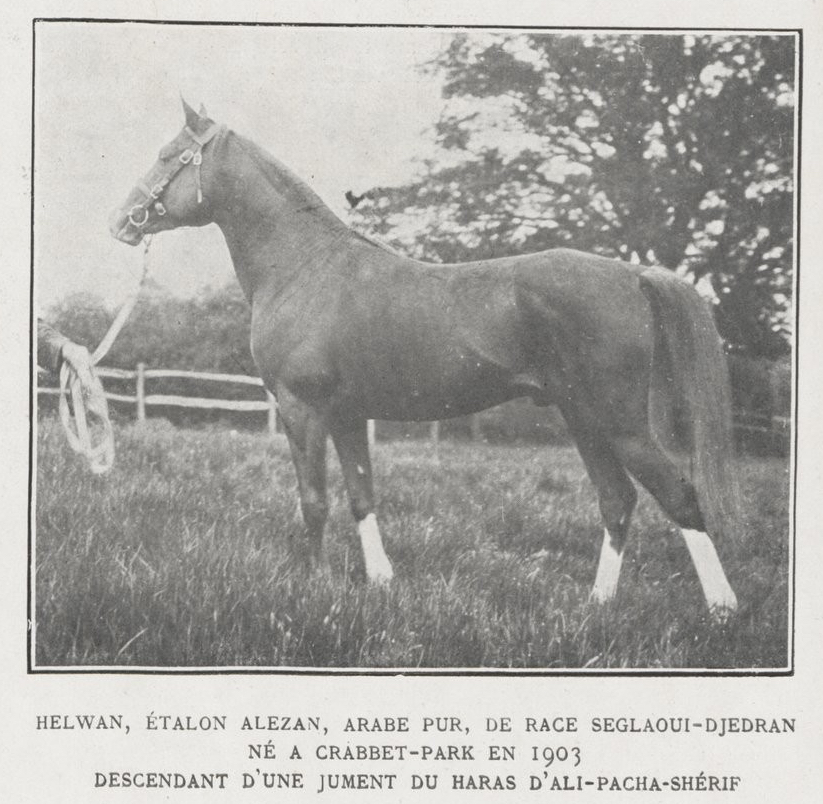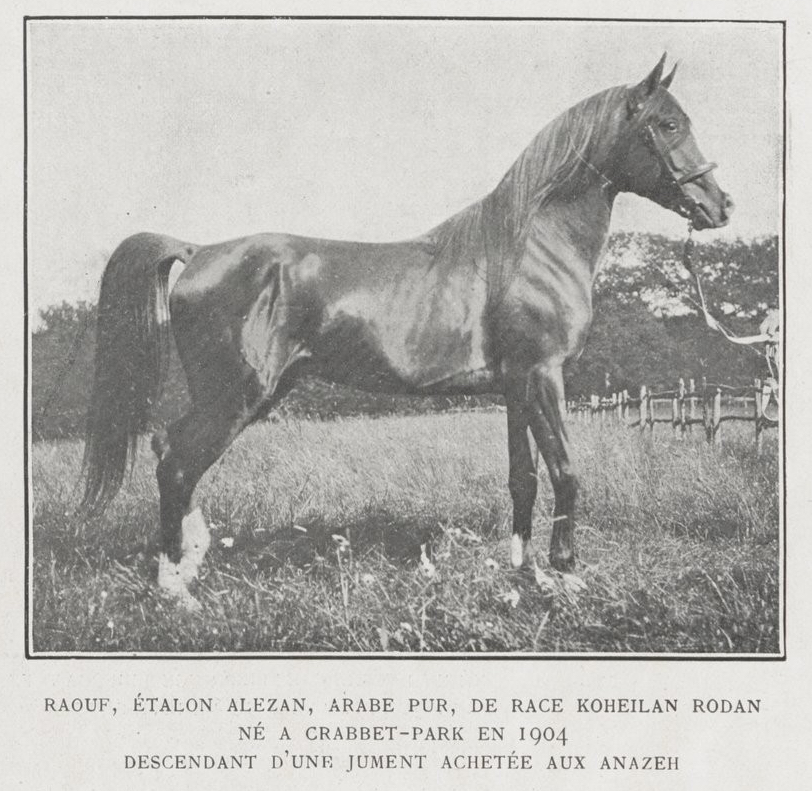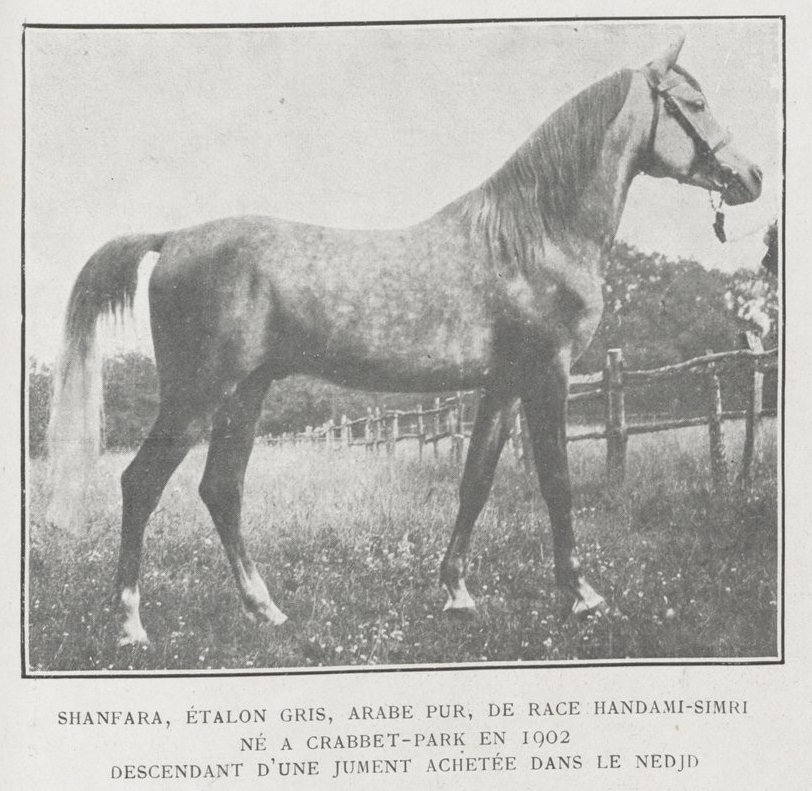Some lesser-known Crabbets
Photos sourced from Le Sport Universel Illustré, no. 906, 21 December 1913
Helwan (Mesaoud x Hilmyeh). He is registered in Vol. 20 of the General Stud Book (GSB), issued in 1905. He was sold to C. E. Poole, of Caledon, South Africa, and exported in 1907. Poole used him on his part-bred Cleveland mares, and Helwan had no recorded purebred get in South Africa. (See Charmaine Grobbelaar, 2007, The Arabian horse and its influence in South Africa.)
Nawab (Astraled x Nefisa). Like Helwan, he too is registered in Vol. 20 of the GSB, but as an unnamed foal for the year 1905; his name, colour and sex are given in Vol. 21 of the GSB, issued in 1909. He was the sire of the mare Selmnab (out of Simrieh), who was imported to the USA by Roger Selby. Unfortunately, Selmnab has no known asil descendants alive today.
The 1937 Selby Stud Brochure of Arabian Horses describes Selmnab as follows:
SELMNAB. (Next page). Bay. 14.0. Foaled 1920. 900 lbs. A Hamdanieh Simrieh. Sire: Nawab. Dam: Simrieh. Bred at Crabbet Stud, England. 812 Arabian Horse Club. 5407 Jockey Club. Selmnab has the wildest desert appearing eye of the group of brood mares. She is of the Simri Strain, which is extinct in the desert. There are Hamdaniehs there, but not of the Simri strain. Selmnab traces to the famous gray Hamdanieh Simrieh of Abbas Pasha. Selmnab’s sire’s sire, Aslraled and sire’s dam, Nefisa, — her great grandsires Champion Mesaoud and Hadban, and her great granddam’s Queen of Sheba and Dajania — were every one notable horses. A steady producer of good foals usually with four white stockings
Raouf (Mesaoud x Rose of Sharon). He is registered in Vol. 20 of the GSB, as an unnamed chestnut colt; his name is given in Vol. 21 of the GSB. Grobbelaar (2007) quotes an advertisement for the 1913 Crabbet Park sale, which describes Raouf as follows:
A finer horse, however, perhaps than either of these is Raouf, 14.3, the last remaining son of the old prize winner Mesaoud. In him is seen a rare combination of strength and quality which breeders from the Colonies will do well to pay attention to.
Shanfara (Seyal x Shieha). He is registered in Vol. 20 of the GSB. He was the sire of the grey colt Kaftan, out of Kibla (Mesaoud x Makbula); Kaftan was gelded, and was owned by Lady Anne Lytton, for whom he proved a successful riding horse in the show ring (see the Rev. D. B. Montefiore’s ‘Arab horses in 1922’, in The Live Stock Journal Annual for 1923).
Raouf and Shanfara were offered at the Crabbet Park sale in 1911, for 300 and 200 guineas respectively, but were not bought (see p. 215 of the Mark Lane Express Agricultural Journal of 7 August 1911). I have not been able to find the outcome of the 1913 sale, at which Raouf was offered again.




They all appear to be very high quality stock!! Can’t really tell which ones are best conformed. Very Hard decision to make.. Mesaoud was such a high quality horse!! I wonder how much it costs to maintain frozen semen for a period of years. And to think the Doyles have what I think are essentially grandsons of Mesaoud at stud.. Food for thought.
best
Bruce Peek
Bruce — interestingly enough, I recently did a survey of the Mesaoud sireline stallions active in the United States. The oldest Doyle stallion that’s active and in this sireline is Carver DE, who is 9 generations from Mesaoud.
I don’t know if this is something you might find interesting, but there’s a 1993 stallion located in Texas that qualifies as what some might term “Old Egyptian” that, last I talked to the owner about a month ago, was still alive — Ibn ElReata Juan (El Reata Juan x Bint Serasabba) who is just 6 generations from Mesaoud, double Julyan with *Astraled still in the 5-generation pedigree. He doesn’t have any sons — which is a shame because this is old old old blood, very hard to come by now.
Carver is dead.
Carver died? OMG. Thanks for letting me know.
Tamaam also died. Ibn Carver is still alive.
Bummer. It really just amazes me that Mesaoud’s sireline, for being such an important cornerstone of Arabians, is so rare in the Al Khamsa population.
The horses bred by the Blunts were definitely quality horses! Mesaoud had a tremendous impact, but he also had good mares available to him, which does help.
These are attractive horses. There is no record of Helwan having been used for breeding at Crabbet, and Nawab, Raouf, and Shanfara were used only very little. Dare I say that in my opinion these four stallions were as good as, and maybe in a couple of cases better than, some of the major Crabbet Stud sires of their era?
Nawab was owned in Lady Anne Blunt’s half of the partitioned Crabbet Stud until June of 1909, when he was part of the exchange when she acquired *Nasik from her husband Wilfrid Blunt’s half. Their daughter Lady Wentworth described Nawab: “15.1 Bone 8. Dark bay with the loveliest head & neck & forehand. Superb flashing eye of enormous size.” (You can see the eye in the photo of him under saddle, although not in the photo above, and apparently Nawab passed that eye on to his daughter *Selmnab.) Lady Wentworth went on: “A most delicate skin showing all the veins of the neck & shoulder. Sold to an unrecorded purchaser 1910 & resold to Mr. Warren of Lewes much the worse for knocking about & his temper ruined.” Lady Wentworth repurchased Nawab for Crabbet in 1919 and bred him to Simrieh, in the years after her mother Lady Anne Blunt died and before the lawsuit against her father over ownership of the Crabbet Stud was decided in her favor in 1920. Lady Wentworth sold Simrieh, in foal to Nawab with *Selmnab, to S.G. Hough in June of 1920, and also sold Nawab to Egypt in 1920.
Raouf was another that Lady Anne sold to her husband Wilfrid in June of 1909. He was bred to Riyala in 1911, but she did not settle. Lady Wentworth described Raouf: “A fine upstanding very showy horse. Strong.” Wilfrid Blunt sold Raouf to Dr. Ryan of Melbourne, Australia in 1914.
Shanfara apparently belonged to Wilfrid Blunt following the Crabbet Stud partition in 1906, who then sold Shanfara to his daughter Judith (Lady Wentworth) in 1907. In June 1909, Judith made Shanfara over to her mother Lady Anne in part payment for the mare Riyala. Wilfrid Blunt then repurchased Shanfara from Lady Anne (Shanfara was bred to Wilfrid Blunt’s mare Kibla in March 1910 to produce Kaftan), and then Blunt gave Shanfara to his grandson Anthony Lytton in January, 1913. According to Lady Wentworth, Anthony exchanged Shanfara for Lady Anne’s stallion Rasim in 1914. Despite this statement, Rasim is never absent from Lady Anne’s annual Crabbet Stud catalogs, and Shanfara does not appear in Lady Anne’s 1914 or 1915 catalogs. In any event, Shanfara was sold at Tattersalls in 1915 with Lady Anne’s driving pair Sinjar and Sindian (also sired by Seyal) for what Lady Wentworth called “the absurd price of 25gs.”
The breeding that produced Kaftan was a step in the Blunt flirtation with returning the Azrek sire line to Crabbet, which ultimately came to naught.
Shortly before partition Nejran (Azrek x Nefisa) had been bought back from a pony breeder and used to sire a few foals. The significant one proved his 1903 daughter Rish who who had a career as a field hunter before she produced Rishan, Rishna and Rishafa. None of Nejran’s colts was used for Arabian breeding.
Early in her tenure as sole owner of Crabbet, Lady Wentworth imported through an agent Minaret, a 1916 double grandson of Rafyk (Azrek x *Rose of Sharon), from Australia. Her private notes indicate the horse was sold as “too small,” but it seems almost certain Her Ladyship had been unable to register him, since at that time there was no registration authority for Australian Arabians. Not only Minaret, but both his parents, were unregistered horses.
And I spoke too soon, I had Shanfara’s pedigree upside down. It’s his dam who was by Azrek, Wilfrid Blunt’s riding mare Shieha.